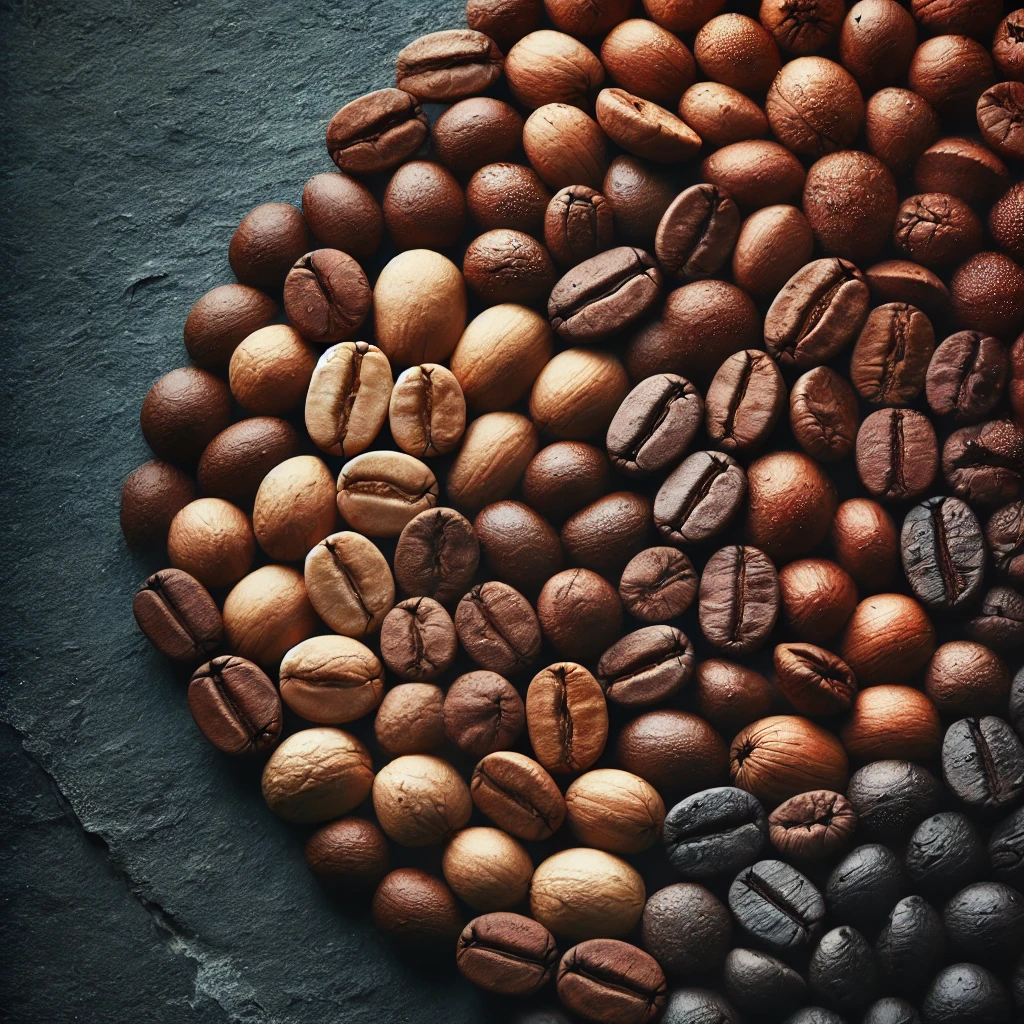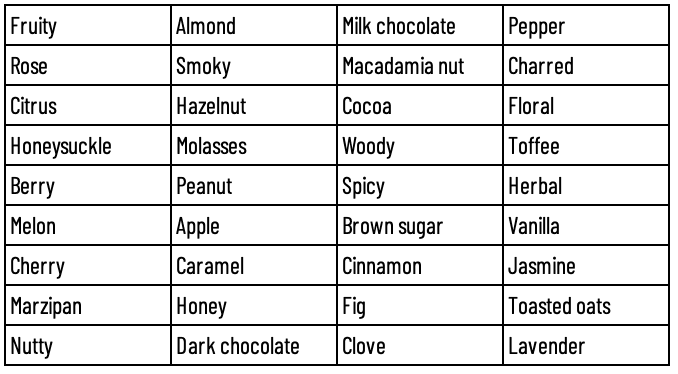
The Ultimate Guide to Choosing the Best Coffee Blend for Your Taste
Learn how roasters craft harmonious blends by combining different origins, roast levels, and processing methods.
Discover seven factors to consider when choosing a coffee blend, from tasting notes to brewing methods.
Transform your coffee journey with our coffee tasting guide and coffee blend tips!
Coffee roasters are true artists, carefully selecting green coffees and roasting their beans to create unique flavor profiles. They craft masterpieces, whether that’s a single-origin coffee—an acapella solo showcasing the unique characteristics of a specific region and varietal—or a blend—a harmonious symphony of different origins working together to create a complex and balanced composition.
They consider factors like origin, roast level, and flavor notes to achieve the desired taste and spend lots of time cupping to not only get a true sense of the beans’ potential flavors but also decide what combinations and ratios will achieve the most delicious results. Whether you’re a coffee expert or looking for a guide to coffee for beginners, we’ll teach you to think a little like a roaster with this coffee flavor guide!
What Is a Coffee Blend?
When you see the term “blend” on a bag, it means the roast is a mixture of coffee beans from two or more different origins. That could mean anything from coffees from completely different continents to coffees from different microclimates within the same region. This blending process creates a unique flavor profile and allows for a wide range of flavors, from smooth and balanced to bold and complex.
Roasters create blends in one of two ways. Sometimes they mix green coffees from different origins and then roast the entire blend together. Sometimes they roast the different green coffees separately and then mix together the roasted beans.
Roasters create blends for a variety of reasons, including:
- Consistency: Blending different coffee beans can help to create a more consistent flavor profile, especially when sourcing from various regions or harvests.
- Complexity: Combining different coffee beans with unique flavor profiles can create a more complex and interesting cup of coffee.
- Seasonal Offerings: Roasters can create seasonal blends by combining beans from specific harvests or regions.
Coffee Flavor Guide: Understanding Tasting Notes
So how can you choose the best coffee blend to suit your tastes? First you need to know what flavors you’re most drawn to.
What flavors really call out to you when you’re drinking that perfect cup? Do you love something bright and fruity? Do you love coffee that feels rich and heavy on your tongue? Do you like something smooth and nutty? Whether you’re a coffee expert or a beginner, you’ve probably got a solid instinct about the kinds of flavors you prefer. Here are some flavor descriptions to get you thinking:

Trust your gut here! Even if you can’t imagine what “woody” or “apple” coffee would taste like, you probably had an automatic reaction to the idea. That’s a good instinct to follow! (But don’t be afraid to step outside of your comfort zone and try something new—you never know when a flavor profile will surprise you in the best possible way!)
One more thing to note here: These flavors are all natural products of the beans’ organic compounds and the roasting process. They come from the beans themselves and aren’t flavors that are added on top of the beans. Flavored coffees are made by either infusing beans with extra ingredients or coating them with flavored syrups or oils as part of the roasting process.
How to Choose Coffee Blends: 7 Factors to Consider
Once you know the flavors you love, you can use those preferences to help you decide on blends that will fit your palate. But how can you figure out whether a blend will hit all the right notes for you? Here’s your official cheat sheet: seven of our best coffee blend tips!
1. Coffee Tasting Notes
This is your first stop in your blend research! The roaster has invested time, money, energy, attention, passion, and love in developing a particular flavor profile for their whole bean coffee and bringing that vision to life. So they’re probably going to want to tell you all about it! Many roasters will give you tasting notes right there on the outside bag, and that’s a great place to start in choosing a blend.
- If you know that you love a rich, nutty coffee, look for keywords like hazelnut, brown sugar, macadamia nut, and toffee.
If you’re looking for something to get you started in your taste-testing, try our Perfectly Wired, with tasting notes of rich chocolate, nutty toffee, and a hint of citrus!
- If you like something a bit sweet and spicy, look for keywords like cinnamon, clove, marzipan, and milk chocolate.
Check out our 1871 Founder’s Blend, with tasting notes of sweet nuttiness, caramel, and a hint of spice!
- If you like flavors that are bold, rich, and sweet, look for keywords like dark chocolate, molasses, smoky, and fig.
Try our Espresso Obsessed, with tasting notes of dark chocolate with a bit of smokiness and berries.
2. Coffee Roast Level
The roasting process significantly impacts a coffee bean’s flavor profile, so you’ll want to look for whether the blend is marked as a light, medium, or dark roast coffee. Light roasts carry more of the flavor from the original green coffee, so they’re more likely to be floral or fruity; dark roasts, on the other hand, allow more time for the sugars in the beans to caramelize, creating a fuller body and a more bitter flavor.
- Light Roast: High acidity, bright flavors, and a delicate body.
- Medium Roast: Balanced acidity, sweetness, and bitterness, with a medium body.
- Dark Roast: Low acidity, pronounced bitterness, and a full body.
3. Wash
The way coffee cherries are processed—the method used to remove the flesh, mucilage, and/or skin from the cherries in order to reveal the pit—significantly impacts the final flavor of the coffee. Here are the three main processing methods and what they can tell you about the flavors inside:
- Washed: This is the most common processing method, where the coffee cherries are fermented for 18–36 hours, then washed to remove all of the pulp, and dried. It results in a clean, bright cup with clear acidity and a focus on more floral flavors.
- Natural: Also known as the dry process, the coffee cherries are dried whole, with the fruit still intact. This method often results in a heavy body and intense, sweet flavors.
- Honey Process: This process walks the line between natural and washed. The skin of the coffee cherry is stripped off, along with some of the pulp, but a thin layer of mucilage is left on the bean. This method can produce a wide range of flavors, depending on the level of mucilage left on the beans, but honey-processed beans tend to be sweeter, fruity, and low in acidity.
4. Origin
Knowing a little about the different coffee origins included in the blend can tell you a lot about the flavors it highlights. The altitude, soil, climate, temperature, and growing practices in the area where the coffee produced shapes its flavors. Here are a few examples of how coffee origin can shape its flavor:
- Costa Rican coffees are known for their bright acidity, fruity notes, and clean finish.
- Colombian coffees are known for their smooth, balanced flavors with nutty, chocolaty flavors with hints of fruitiness.
- Ethiopian coffees are known for their bright, complex flavors with notes of berries and florals.
- Indonesian coffees are earthy and spicy with notes of dark chocolate.
It’s also important to note, though, that each country has unique growing regions, each with their own unique flavor profiles. For example, in Colombia, coffee from the Huila Region, which is known for its high humidity and relatively low temperatures, produces coffees that are sweet and medium-bodied with high acidity, intense aroma, and a fruity, caramelized flavor. Coffees from the Santander region, on the other hand, where the dry climate and many farmer use shade-grown practices, are fuller-bodied, medium acidity, with sweet, herbal notes and hints of citrus.
5. Coffee Species/Varietal
The type of coffee bean used can also significantly impact the flavor profile. Here are the three most common types of coffee beans:
- Arabica: This is the most widely cultivated coffee bean, known for its complex flavors and high acidity.
- Robusta: Bold, intense, with characteristic bitterness. Earthy, woody, chocolaty, nutty notes.
- Liberica: Complex, smoky, woody with hints of dark chocolate, fruit, and even floral notes.
Those three types of coffee beans also produce a number of varietals, each with its own flavor profile. Here are just a few examples from the 120 different varietals:
- Bourbon: Sweet, balanced, with notes of berries, chocolate, and nuts
- Pacamara: Complex and full-bodied with notes of chocolate, caramel, and hints of spice
- Caturra: Bright, fruity, sweet, and clean
- Gesha: Delicate, smooth, floral, citrus, and tropical fruits
Many roasters will share what types/varietals they’re using in their blends, and in what ratios, so you can use that information to help you get a sense of what flavors might be in the finished roast!
6. Brewing Method
If you’re purchasing a blend to brew at home, keep in mind that the brewing method you use can dramatically affect the flavors of the coffee. For example, pour-over coffee brewing works especially well with coffees that have fruity, acidic flavor profiles. If you love a pulled espresso, on the other hand, blends that include darker roasts with chocolatey, nutty flavors might work better.
Check out our guide for more on brewing different roast profiles: How to Brew Light, Medium & Dark Roast Coffee.
7. Green Coffee Sourcing
Sustainable sourcing is important for so many reasons, but it’s worth noting the company’s values and mission when you choose a blend because it can tell you a lot about the level of thought and intentionality that goes into creating their blends.
Roasters who place value in sourcing that focuses on environmentally, financially, and socially sustainable coffee value their coffee deeply, which means that they tend to be intentional in their roasting practices and blend recipes. When you respect the amount of work it takes to produce amazing coffee, you want to honor it by creating something incredible. A reputable roaster will source high-quality beans and work hard to roast them to perfection.
Finding the Best Coffee Blend
Now that you’ve embarked on a journey to discover the best coffee blend, we hope this guide has equipped with the knowledge you need to make informed decisions! Remember, coffee roasting is an art form, and understanding the various elements at play—from origin and processing to roast level and varietal—empowers you to explore the vast landscape of flavors.
You can also get to know your local roaster and ask them about the flavors in their blends and what they recommend based on what you love most—they love to talk to customers!
Don’t be afraid to experiment! Embrace the opportunity to try single-origin coffees and appreciate their unique characteristics. Sample blends crafted by passionate roasters, noticing how they combine different beans to create a harmonious symphony of flavors.
Here’s one last tip: Your local coffee shop is a treasure trove of knowledge. Talk to your barista or your roaster! They’re coffee enthusiasts who can answer your questions, recommend blends based on your preferences, give you coffee blend tips, and guide you through the exciting world of coffee. After all, sharing the joy of a perfectly brewed cup is what coffee is all about!
Cheers to you for diving deep into the world of coffee with us! U3 Coffee exists to create the most meaningful coffee experience for millions of mindful, motivated humans like you. Let’s learn, empower, and celebrate the journey from bean to cup. Because here, we’re United by Coffee.
Related posts
- Apr 2025 Elevate your coffee-based cocktails! Discover new takes on the espresso martini, Irish coffee, & more classic coffee drinks.
- Feb 2025 Discover the top coffee trends for 2025, from cold coffee innovations to mindful coffee drinking. Explore the latest and future coffee trends in the coffee industry.


